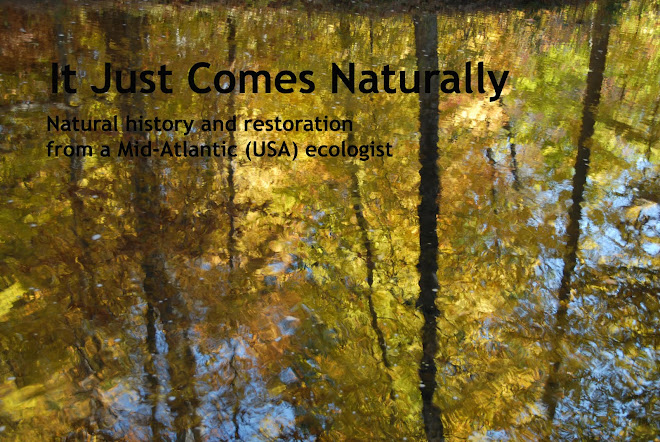Now that I've got your attention...
 |
| On the wood-chipped path outside my office |
Of late, I'm obsessed with slime mold, and one species in particular: Fuligo septica. Last year, a neighbor cut down several large tuliptrees that had grown too near his house. His arborist chipped the wood, and our organization took the wood chips for our trails. This spring, the wood chipped trail has come alive repeatedly with slime mold aggregations.
At first, this slime mold is a strikingly bright, brilliant yellow.
 |
| Image from Wikipedia |
 |
| Image from Wikipedia |
But after a day or so, it turns dun-colored and looks like its common name.
I knew this organism was a slime mold, but I knew very little about it, so I checked out the citation on Wikipedia and found out that Dog Vomit Slime (also known in more genteel circles as Scrambled Egg Slime [still not too appetizing] or Flowers of Tan) is one of the most common and widely distributed of the slime molds.
Slime molds are not molds (i.e., fungus) at all despite their common name. They and the other protists (i.e., single celled organisms) are lumped into their own kingdom equivalent to the animals, plants, and fungi, but the classification is constantly in flux because the relationships among these organisms are so poorly known and understood.
Like many slime molds, the cells of this species typically live independently, then based on some unknown cue, they come together and aggregate to form a plasmodium. Each cell gives up its individual existence and merges its cell body and nucleus into a mass that may move in an amoeba-like fashion in search of nutrients. F. septica's plasmodium may range from white to yellow-gray, and is typically 1-8 inches in diameter and 0.4–1.2 inches thick. The plasmodium eventually transforms into a sponge-like aethalium, analogous to the spore-bearing fruiting body of a mushroom, which then degrades, darkens in color, and releases its dark-colored spores. F. septica produces the largest aethalium of any slime mold.
 |
| Close-up image of the aethalium. Soo cool! |
In Estonian mythology, the aethalium was thought to be the leftovers from a kratt, a creature created by farmers out of hay and/or farm implements, given life by the devil after the farmer surrendered three drops of blood, and obligated to do the farmer's bidding. F. septica in Finland was believed to be used by witches to spoil their neighbors' milk. This gives it the name paranvoi, meaning "butter of the familiar spirit." In Flemish, it is known as "heksenboter," which refers to "witch's butter."
What strikes me as most odd is that none of the myriad visitors to my preserve that walk past the slime molds ever come in to inquire about them, especially when they're in their bright yellow stage.
































